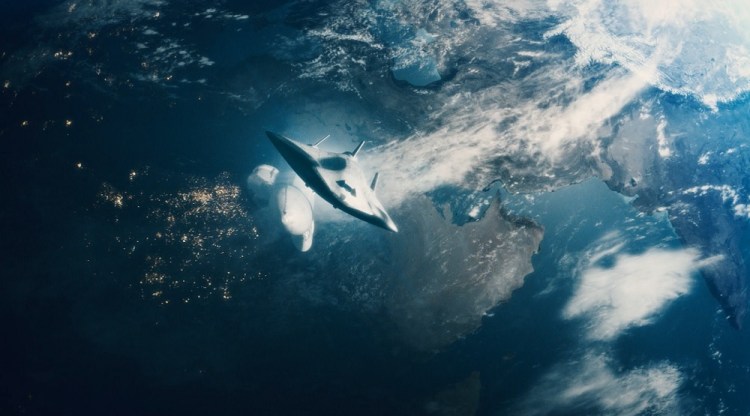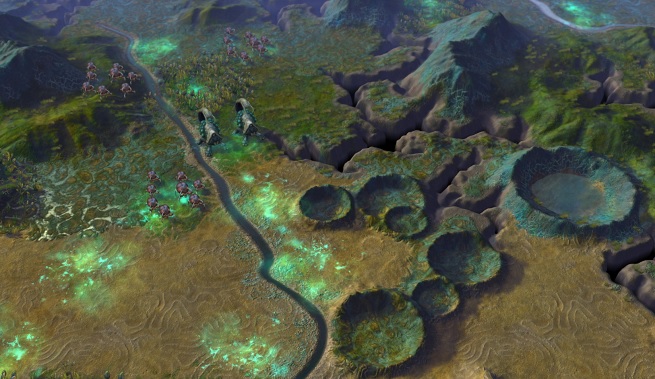GamesBeat: What’s different about the gameplay versus previous Civilizations, and what’s very similar?
McDonough: The phrase we like to use is, “Beyond Earth is built on the bones of Civilization.” Civilization V, specifically. It belongs in the Civ franchise, and a lot of the things a Civ player likes about Civ and has come to expect about the Civ style of gameplay, they’ll find at the heart of this one. That’s things like one unit per tile, hexes, cities, buildings, improvements, wonders, warfare, and so on … . Lots of things.
But after that, we’ve created an entirely new blend of experiences on those bones. A different flesh for the body. Everything from how your technology emerges and what value you place on it to what governs when and where [you want] to build cities and what cities do for you. How do you interact with your neighbors on this alien planet, when all of you are trying to figure it out at the same time?
To describe the differences is basically to describe the game. It’s a new experience designed around the kernel of the Civ idea but for a context that it belongs in — the future, the advancement of technology, the alien planet.
Miller: A couple of specifics will stand out to players. The first thing you’ll notice — beyond the first beat of the game, which is that loadout and landing process — is the alien world. The aliens are characters, and the world is a character, just as much as the other civilizations are. You don’t interact with them diplomatically, but they certainly react to what you’re doing. Figuring out how to negotiate their presence is a big deal.
The tech tree is now a tech web. It’s nonlinear tech advancement. In traditional Civ, you sort of move from left to right, researching tech along the way. You research all of them by the end of the game — maybe in different order or at different paces, but everyone gets the same stuff at the end. In this game, you research some subset of the tech. You’re not going to get to all of it. You have to make choices about what you want to prioritize.
The way that unit progression works has been totally redone to emphasize these three technology affinities, these post-human manifestations of our future. That’s a big system that’s pretty exciting. There are lots of things like this that Civ players will appreciate as being very new, but they’ll still feel comfortable because it’s built on a Civ game that they’re familiar with.
GamesBeat: With Alpha Centauri, we had one planet and we played on that. Here you give the opportunity to have many different kinds of environments that seem like they’re different planets. How much variety is there?
McDonough: There are two ways we differentiate the planets. The first way is with [biomes]. The game ships with three very distinctive biomes. There’s a lush biome — very green, lots of jungle, and all of that. There’s a fungal biome, which is very strange — fungus and lichen all over the place, a very cool color temperature. Then there’s an arid biome … very little water, sand everywhere.
Each of these is additionally augmented by our map scripts. We have a lot of map scripts that tell the game how to generate the environments — what the distributions of resources are, what the land masses look like, things like that. Those have been rewritten to take advantage of our new resource types and new terrain features. Within those three biomes, you have a lot of variation in terms of the kind of map you’ll be playing on.
GamesBeat: When you’re in a state of warfare, how would you describe that?
McDonough: It’s warfare along themes you might recognize. The civilizations on the planet are vying for control of a variety of things. They’re also trying to fight against the aliens who precede them and aren’t necessarily going to be their friends. So, you fight on the planet’s surface with units, focusing on themes you’d recognize from Civ V.
The biggest difference is that the construction of your army is totally overhauled. Previously, you might [have had] a historical prerequisite and an advancement through the ages of military tech. In this game, you have a core cadre of units and classes, and you customize and upgrade them over the course of the game. You get new technologies and various perks from all kinds of activities.
By the end of the game, your army reflects a unique blend of advantages and styles that represent all the decisions you’ve made. No two armies will be the same. You could be fighting head to head against your neighboring civ with armies that are radically different. They look different, operate differently, represent different people. But you’re still having a balanced war. It’s still tactically interesting and challenging. The warfare has a totally different feel to it, with unit customization as its foundation.
Miller: The other noticeable difference, a feature that we’re really excited about, is the orbital layer. What would a space game be without some gameplay in space, right? So, you send aloft these satellites, which project an influence on the terrain below. They’re stationary, but they’re floating improvements. You can send up a tactical satellite and buff all the units underneath it. There’s this kind of spatial territorial-acquisition game that players play in the orbital layer. It’s a separate conquest game where you’re vying for control of the airspace. That’s a neat twist on Civ combat. It’s been a lot of fun to play with.
GamesBeat: Are you getting some input from Sid Meier [director of creative development at Firaxis] on this as well?
McDonough: Definitely. Sid is sort of the guiding light of every project at Firaxis. As lead designers, we talk to him and get mentorship from him on pretty much everything we do. This game is no exception. He’s been a wonderful asset, great to go and talk to about the various design ideas and directions we’ve been taking. He’s a fan of the game, which is high praise. It’s been fun working with Sid.
GamesBeat: What’s a thing you think people are going to obsess over?
Miller: There are so many things to do in a Civilization game. There’s this rolling progression of choice and reward and feedback. That loop, that compulsion loop, is what keeps people in the game. I started researching a tech 15 turns ago. I want to see it when it’s finished. Then, it gives me these things I want to build and see the results of. It’s very easy to get sucked into this game and lose a lot of time.
One of the things I think is most compelling is when you start to establish your affinity. There’s a point in the game where the visual identity of your civilization starts to take on the characteristics of the affinity you’ve chosen. That moment, where it feels like the decisions you’ve made really start to have a significant impact on your imaginary people, that’s a moment that really … I don’t want to stop playing. As soon as my cities start to reflect my ideology or those troops get that first taste of the new ideology style, that’s a fantastic hook to keep going.

VentureBeat's mission is to be a digital town square for technical decision-makers to gain knowledge about transformative enterprise technology and transact. Learn More



